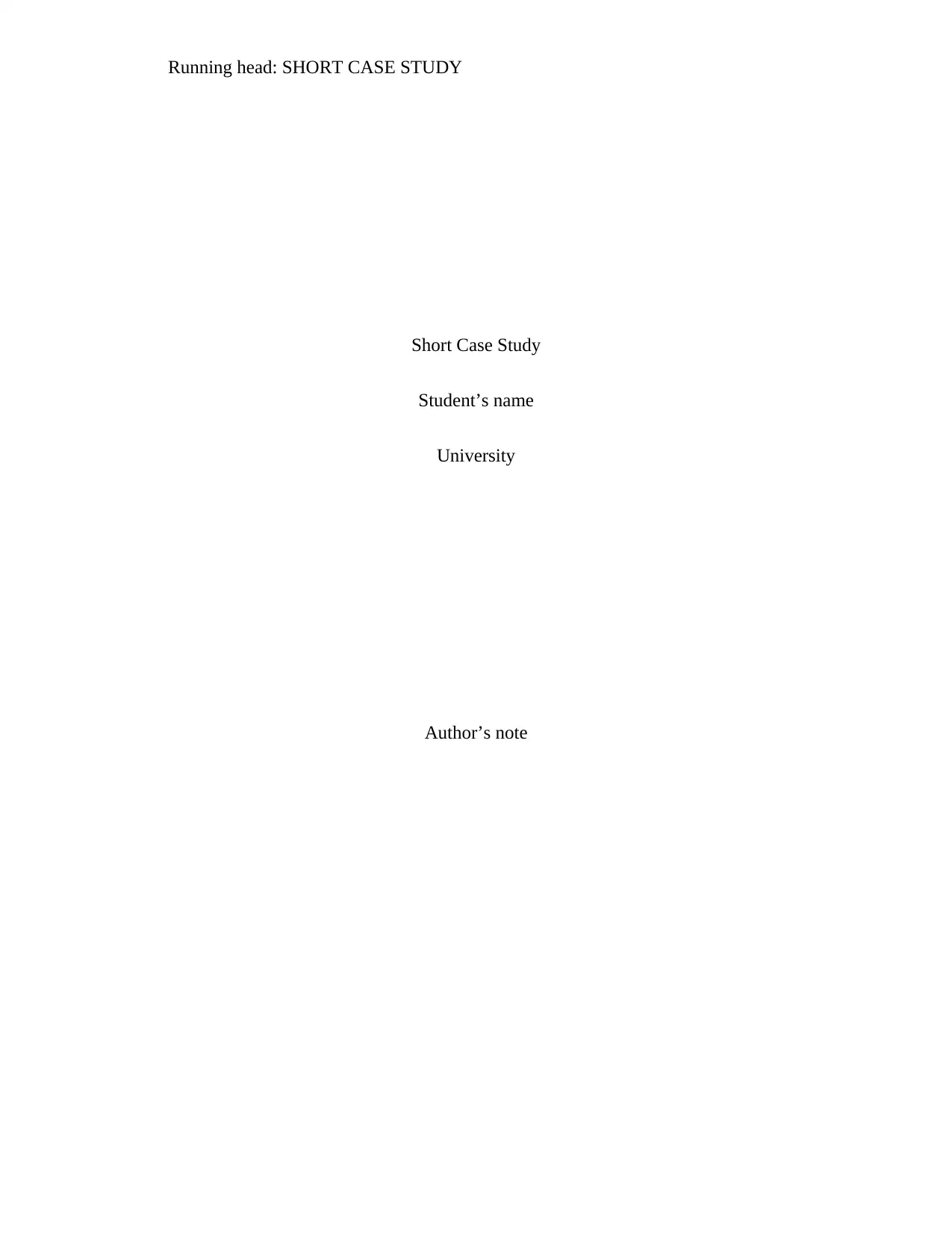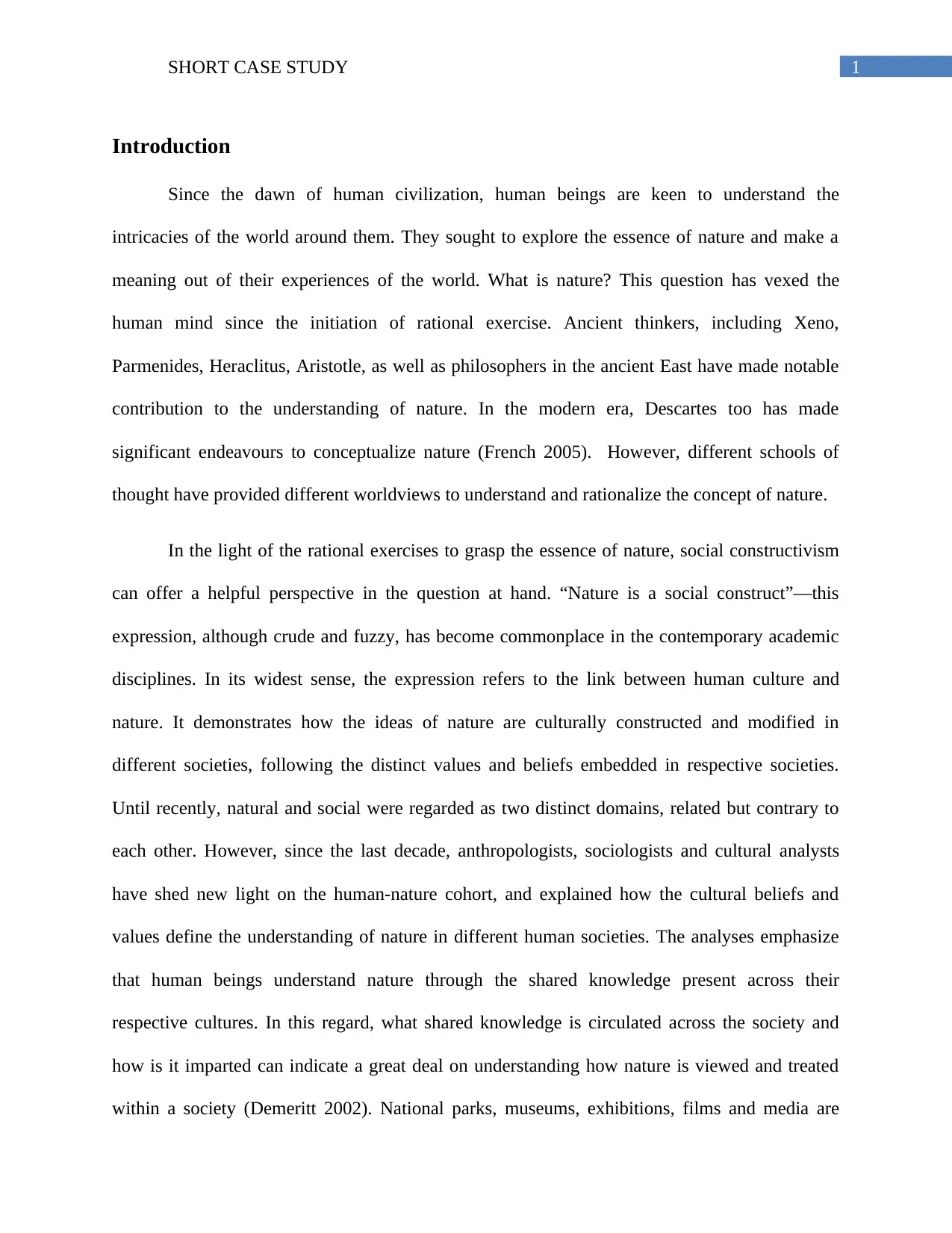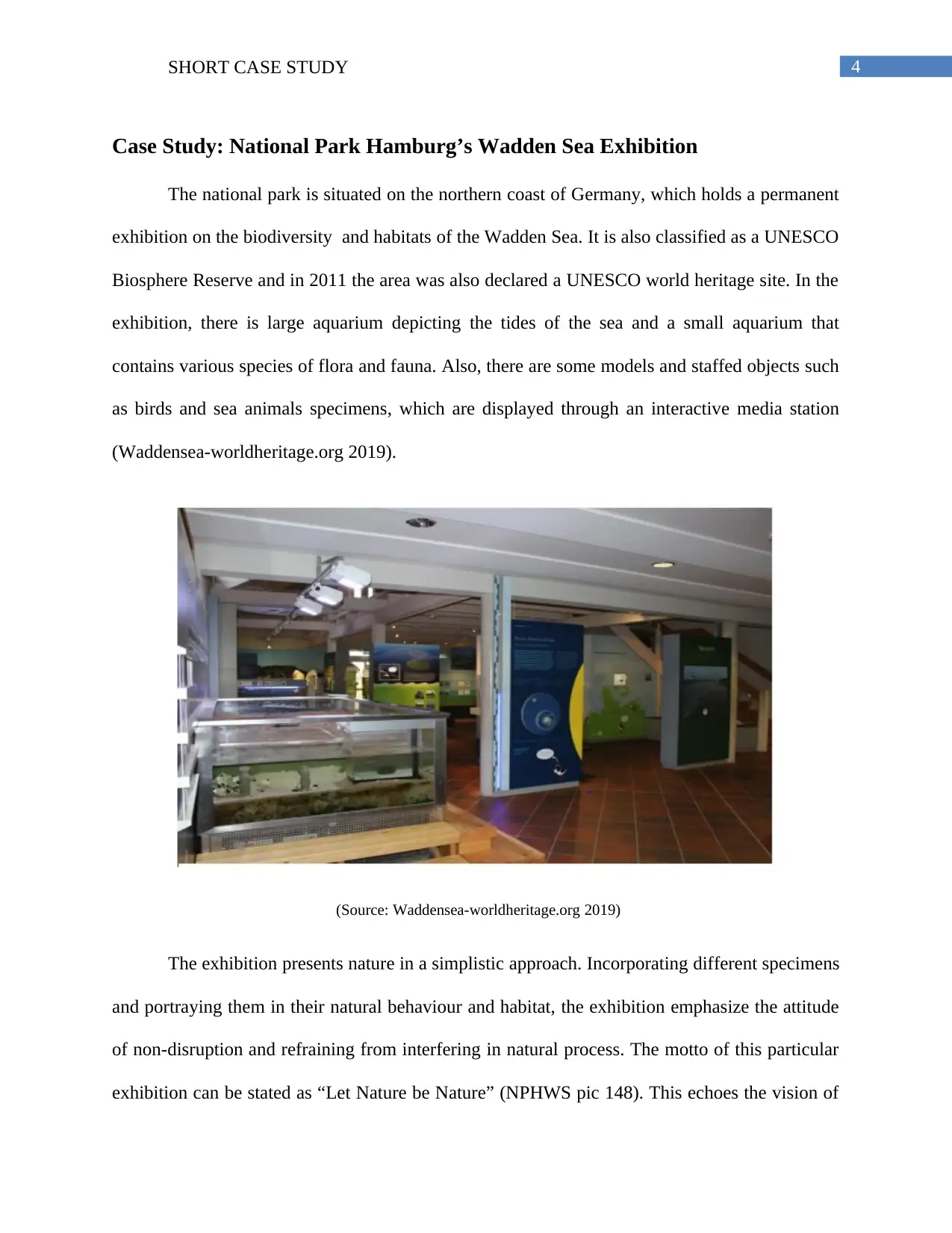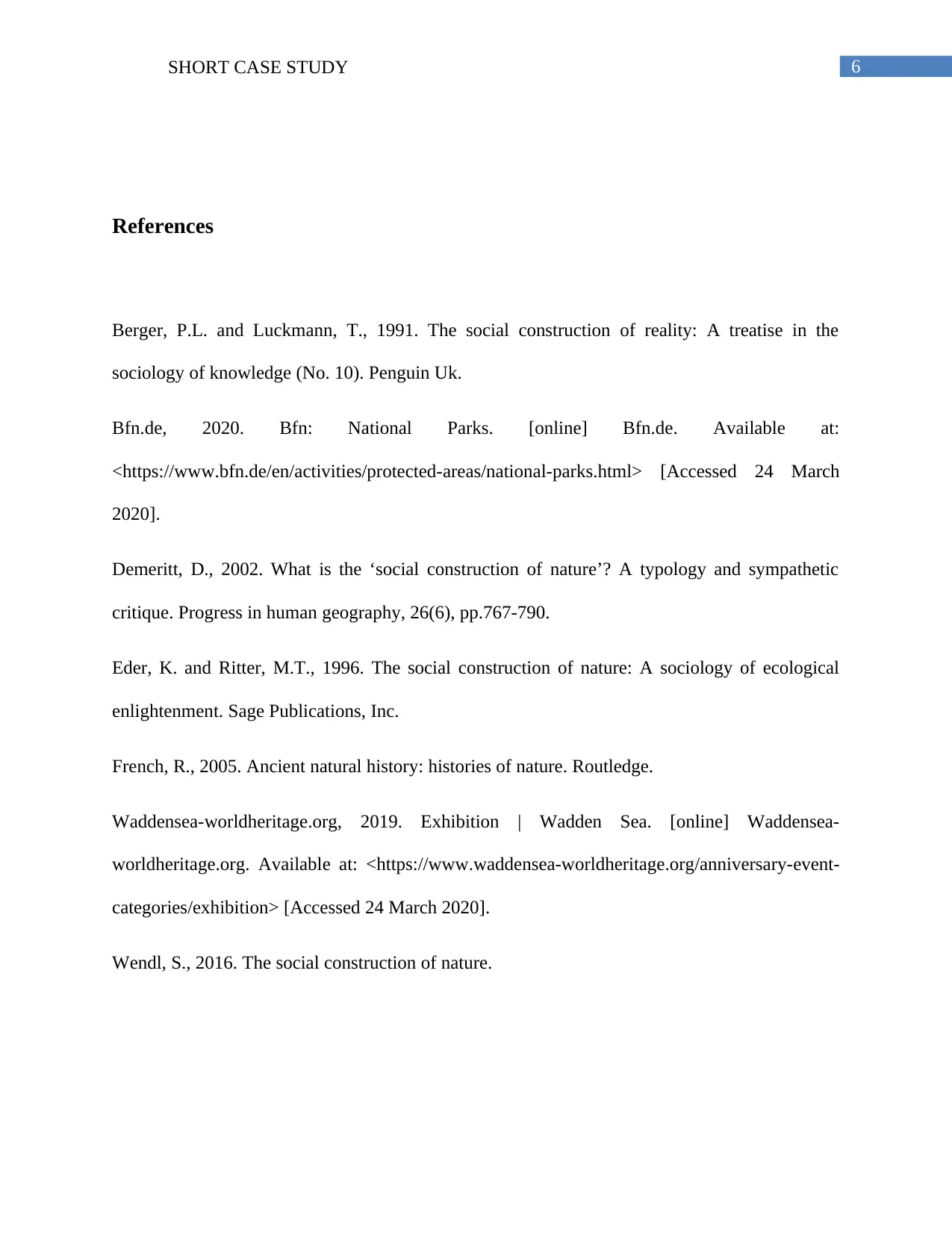Analyzing the Social Construct of Nature: A Short Case Study
VerifiedAdded on 2022/08/26
|7
|1504
|18
Case Study
AI Summary
This case study examines the social construct of nature, arguing that our understanding of nature is shaped by cultural beliefs and shared knowledge. It explores how societies, through their values and practices, define and interact with the natural world. The study references key sociological concepts and theorists like Berger and Luckmann, and Eder and Ritter, to provide a comprehensive overview. The core argument is that the way we perceive and treat nature is not inherent but is a product of social construction. The study then presents a case study of the National Park Hamburg’s Wadden Sea Exhibition to illustrate how exhibitions and public spaces contribute to the circulation of shared knowledge about nature and influence public attitudes. The exhibition's design and messaging, emphasizing non-interference with natural processes, are analyzed as reflections of a specific social construct of nature. The conclusion emphasizes the importance of understanding this social construct in the context of environmental degradation, advocating for a re-evaluation of our relationship with nature based on the insights of social constructivism.

Running head: SHORT CASE STUDY
Short Case Study
Student’s name
University
Author’s note
Short Case Study
Student’s name
University
Author’s note
Paraphrase This Document
Need a fresh take? Get an instant paraphrase of this document with our AI Paraphraser

1SHORT CASE STUDY
Introduction
Since the dawn of human civilization, human beings are keen to understand the
intricacies of the world around them. They sought to explore the essence of nature and make a
meaning out of their experiences of the world. What is nature? This question has vexed the
human mind since the initiation of rational exercise. Ancient thinkers, including Xeno,
Parmenides, Heraclitus, Aristotle, as well as philosophers in the ancient East have made notable
contribution to the understanding of nature. In the modern era, Descartes too has made
significant endeavours to conceptualize nature (French 2005). However, different schools of
thought have provided different worldviews to understand and rationalize the concept of nature.
In the light of the rational exercises to grasp the essence of nature, social constructivism
can offer a helpful perspective in the question at hand. “Nature is a social construct”—this
expression, although crude and fuzzy, has become commonplace in the contemporary academic
disciplines. In its widest sense, the expression refers to the link between human culture and
nature. It demonstrates how the ideas of nature are culturally constructed and modified in
different societies, following the distinct values and beliefs embedded in respective societies.
Until recently, natural and social were regarded as two distinct domains, related but contrary to
each other. However, since the last decade, anthropologists, sociologists and cultural analysts
have shed new light on the human-nature cohort, and explained how the cultural beliefs and
values define the understanding of nature in different human societies. The analyses emphasize
that human beings understand nature through the shared knowledge present across their
respective cultures. In this regard, what shared knowledge is circulated across the society and
how is it imparted can indicate a great deal on understanding how nature is viewed and treated
within a society (Demeritt 2002). National parks, museums, exhibitions, films and media are
Introduction
Since the dawn of human civilization, human beings are keen to understand the
intricacies of the world around them. They sought to explore the essence of nature and make a
meaning out of their experiences of the world. What is nature? This question has vexed the
human mind since the initiation of rational exercise. Ancient thinkers, including Xeno,
Parmenides, Heraclitus, Aristotle, as well as philosophers in the ancient East have made notable
contribution to the understanding of nature. In the modern era, Descartes too has made
significant endeavours to conceptualize nature (French 2005). However, different schools of
thought have provided different worldviews to understand and rationalize the concept of nature.
In the light of the rational exercises to grasp the essence of nature, social constructivism
can offer a helpful perspective in the question at hand. “Nature is a social construct”—this
expression, although crude and fuzzy, has become commonplace in the contemporary academic
disciplines. In its widest sense, the expression refers to the link between human culture and
nature. It demonstrates how the ideas of nature are culturally constructed and modified in
different societies, following the distinct values and beliefs embedded in respective societies.
Until recently, natural and social were regarded as two distinct domains, related but contrary to
each other. However, since the last decade, anthropologists, sociologists and cultural analysts
have shed new light on the human-nature cohort, and explained how the cultural beliefs and
values define the understanding of nature in different human societies. The analyses emphasize
that human beings understand nature through the shared knowledge present across their
respective cultures. In this regard, what shared knowledge is circulated across the society and
how is it imparted can indicate a great deal on understanding how nature is viewed and treated
within a society (Demeritt 2002). National parks, museums, exhibitions, films and media are

2SHORT CASE STUDY
exemplary cases through which the circulation pattern and attitude could be understood in the
context of a particular society. Hence, along with discussing the meaning of social construct of
nature, the present study will also explore the case of National Park Hamburg’s Wadden Sea
Exhibition to understand how it contributes to the circulation of common knowledge pertaining
to nature and how does that define the public attitude.
Meaning of Social Construction of Nature
According to Burger and Luckmann (1991), society is built on the human activities that
express meaning. In this regard, human knowledge of social aspects can be demonstrated as
based on linguistic, historical and social contexts as well as conventions. The universal
categories existing in the human knowledge essentially depend on cultural contexts for their
meaning, asserts the author. Most recently, this concept has been applied in the context of
understanding environment as well. In purview of this consideration, nature itself, understood as
non-human, undomesticated wilderness is fundamentally a result of human convention of
naming and cultural practices. This notion fortifies the observation that the way human beings
view or consider nature determines their treatment of nature and natural systems. The authors
define shared or common knowledge as “the knowledge I share with others in the normal, self-
evident routines of everyday life” (Berger and Luckmann 1991). It regulates the social
interaction and connects theoretical knowledge with our everyday practice. Through the constant
participation in social interaction, the stock of knowledge seems real, as it is experienced to be
present in others as well. Thus, the shared knowledge circulated through social interaction makes
our experience objective reality. Similarly, the idea of nature, as regarded by the society as a
exemplary cases through which the circulation pattern and attitude could be understood in the
context of a particular society. Hence, along with discussing the meaning of social construct of
nature, the present study will also explore the case of National Park Hamburg’s Wadden Sea
Exhibition to understand how it contributes to the circulation of common knowledge pertaining
to nature and how does that define the public attitude.
Meaning of Social Construction of Nature
According to Burger and Luckmann (1991), society is built on the human activities that
express meaning. In this regard, human knowledge of social aspects can be demonstrated as
based on linguistic, historical and social contexts as well as conventions. The universal
categories existing in the human knowledge essentially depend on cultural contexts for their
meaning, asserts the author. Most recently, this concept has been applied in the context of
understanding environment as well. In purview of this consideration, nature itself, understood as
non-human, undomesticated wilderness is fundamentally a result of human convention of
naming and cultural practices. This notion fortifies the observation that the way human beings
view or consider nature determines their treatment of nature and natural systems. The authors
define shared or common knowledge as “the knowledge I share with others in the normal, self-
evident routines of everyday life” (Berger and Luckmann 1991). It regulates the social
interaction and connects theoretical knowledge with our everyday practice. Through the constant
participation in social interaction, the stock of knowledge seems real, as it is experienced to be
present in others as well. Thus, the shared knowledge circulated through social interaction makes
our experience objective reality. Similarly, the idea of nature, as regarded by the society as a
⊘ This is a preview!⊘
Do you want full access?
Subscribe today to unlock all pages.

Trusted by 1+ million students worldwide

3SHORT CASE STUDY
whole, is imparted through social interaction and makes nature a reality for every participant
involved in the social interaction (Berger and Luckmann 1991).
Eder and Ritter, in their work The social construction of nature: A sociology of
ecological enlightenment (1996), analyse the symbolisms, taboos and rituals across several
societies to demonstrate the relation between culture, society and nature. Eder also opines that
environmentalism and social construction of nature are instrumental index of social structure and
order.
Importance of Social Construction of Nature
With the current state of development and technological progress, the world is
experiencing an unprecedented environmental degradation. The depletion of natural resources
and the disruption of the ecological systems have compelled the mankind to rethink and reflect
over its treatment with nature. It is interesting to note that the majority of the environmental
degradation, if not all, is an outcome of the human activities on earth. Hence, the social
constructivist perspective could be a key aspect in the contemporary ecological management and
environmental politics. As pointed out by Demeritt (2002), the conception of nature is grounded
on the shared knowledge present in the society. In purview of this notion, how we impart the
shared knowledge to new knowledge seekers has a significant influence on how we perceive,
consider, estimate or interact with nature. Also, what common knowledge is shared across the
present society can help understand its attitude towards nature.
whole, is imparted through social interaction and makes nature a reality for every participant
involved in the social interaction (Berger and Luckmann 1991).
Eder and Ritter, in their work The social construction of nature: A sociology of
ecological enlightenment (1996), analyse the symbolisms, taboos and rituals across several
societies to demonstrate the relation between culture, society and nature. Eder also opines that
environmentalism and social construction of nature are instrumental index of social structure and
order.
Importance of Social Construction of Nature
With the current state of development and technological progress, the world is
experiencing an unprecedented environmental degradation. The depletion of natural resources
and the disruption of the ecological systems have compelled the mankind to rethink and reflect
over its treatment with nature. It is interesting to note that the majority of the environmental
degradation, if not all, is an outcome of the human activities on earth. Hence, the social
constructivist perspective could be a key aspect in the contemporary ecological management and
environmental politics. As pointed out by Demeritt (2002), the conception of nature is grounded
on the shared knowledge present in the society. In purview of this notion, how we impart the
shared knowledge to new knowledge seekers has a significant influence on how we perceive,
consider, estimate or interact with nature. Also, what common knowledge is shared across the
present society can help understand its attitude towards nature.
Paraphrase This Document
Need a fresh take? Get an instant paraphrase of this document with our AI Paraphraser

4SHORT CASE STUDY
Case Study: National Park Hamburg’s Wadden Sea Exhibition
The national park is situated on the northern coast of Germany, which holds a permanent
exhibition on the biodiversity and habitats of the Wadden Sea. It is also classified as a UNESCO
Biosphere Reserve and in 2011 the area was also declared a UNESCO world heritage site. In the
exhibition, there is large aquarium depicting the tides of the sea and a small aquarium that
contains various species of flora and fauna. Also, there are some models and staffed objects such
as birds and sea animals specimens, which are displayed through an interactive media station
(Waddensea-worldheritage.org 2019).
(Source: Waddensea-worldheritage.org 2019)
The exhibition presents nature in a simplistic approach. Incorporating different specimens
and portraying them in their natural behaviour and habitat, the exhibition emphasize the attitude
of non-disruption and refraining from interfering in natural process. The motto of this particular
exhibition can be stated as “Let Nature be Nature” (NPHWS pic 148). This echoes the vision of
Case Study: National Park Hamburg’s Wadden Sea Exhibition
The national park is situated on the northern coast of Germany, which holds a permanent
exhibition on the biodiversity and habitats of the Wadden Sea. It is also classified as a UNESCO
Biosphere Reserve and in 2011 the area was also declared a UNESCO world heritage site. In the
exhibition, there is large aquarium depicting the tides of the sea and a small aquarium that
contains various species of flora and fauna. Also, there are some models and staffed objects such
as birds and sea animals specimens, which are displayed through an interactive media station
(Waddensea-worldheritage.org 2019).
(Source: Waddensea-worldheritage.org 2019)
The exhibition presents nature in a simplistic approach. Incorporating different specimens
and portraying them in their natural behaviour and habitat, the exhibition emphasize the attitude
of non-disruption and refraining from interfering in natural process. The motto of this particular
exhibition can be stated as “Let Nature be Nature” (NPHWS pic 148). This echoes the vision of

5SHORT CASE STUDY
Germany’s central authority of National Parks’ vision, i.e. “Untouched by people” (Bfn.de
2020). At the same time, it links the meaning of nature with the social perception. First, it
discerns the realm of nature from human society, positing an ‘otherness’ on the concept (Wendl
2016). Further, it also sheds light on the ideal treatment of nature that should be practiced by the
people subject to the experience.
Conclusion
In the light of the meaning of social construct of nature, it can be concluded that nature
gets its meaning from the everyday experiences and practices as maintained within a society.
Given the current state of environmental degradation and its perceived consequence on
humankind, it is also high time to understand the essence of nature and treat it accordingly. In
this regard, the case study presented in this study achieves comprehensive success, as it
emphasizes the non-human centric reality of nature and translates its vision with relative
emphasis.
Germany’s central authority of National Parks’ vision, i.e. “Untouched by people” (Bfn.de
2020). At the same time, it links the meaning of nature with the social perception. First, it
discerns the realm of nature from human society, positing an ‘otherness’ on the concept (Wendl
2016). Further, it also sheds light on the ideal treatment of nature that should be practiced by the
people subject to the experience.
Conclusion
In the light of the meaning of social construct of nature, it can be concluded that nature
gets its meaning from the everyday experiences and practices as maintained within a society.
Given the current state of environmental degradation and its perceived consequence on
humankind, it is also high time to understand the essence of nature and treat it accordingly. In
this regard, the case study presented in this study achieves comprehensive success, as it
emphasizes the non-human centric reality of nature and translates its vision with relative
emphasis.
⊘ This is a preview!⊘
Do you want full access?
Subscribe today to unlock all pages.

Trusted by 1+ million students worldwide

6SHORT CASE STUDY
References
Berger, P.L. and Luckmann, T., 1991. The social construction of reality: A treatise in the
sociology of knowledge (No. 10). Penguin Uk.
Bfn.de, 2020. Bfn: National Parks. [online] Bfn.de. Available at:
<https://www.bfn.de/en/activities/protected-areas/national-parks.html> [Accessed 24 March
2020].
Demeritt, D., 2002. What is the ‘social construction of nature’? A typology and sympathetic
critique. Progress in human geography, 26(6), pp.767-790.
Eder, K. and Ritter, M.T., 1996. The social construction of nature: A sociology of ecological
enlightenment. Sage Publications, Inc.
French, R., 2005. Ancient natural history: histories of nature. Routledge.
Waddensea-worldheritage.org, 2019. Exhibition | Wadden Sea. [online] Waddensea-
worldheritage.org. Available at: <https://www.waddensea-worldheritage.org/anniversary-event-
categories/exhibition> [Accessed 24 March 2020].
Wendl, S., 2016. The social construction of nature.
References
Berger, P.L. and Luckmann, T., 1991. The social construction of reality: A treatise in the
sociology of knowledge (No. 10). Penguin Uk.
Bfn.de, 2020. Bfn: National Parks. [online] Bfn.de. Available at:
<https://www.bfn.de/en/activities/protected-areas/national-parks.html> [Accessed 24 March
2020].
Demeritt, D., 2002. What is the ‘social construction of nature’? A typology and sympathetic
critique. Progress in human geography, 26(6), pp.767-790.
Eder, K. and Ritter, M.T., 1996. The social construction of nature: A sociology of ecological
enlightenment. Sage Publications, Inc.
French, R., 2005. Ancient natural history: histories of nature. Routledge.
Waddensea-worldheritage.org, 2019. Exhibition | Wadden Sea. [online] Waddensea-
worldheritage.org. Available at: <https://www.waddensea-worldheritage.org/anniversary-event-
categories/exhibition> [Accessed 24 March 2020].
Wendl, S., 2016. The social construction of nature.
1 out of 7
Related Documents
Your All-in-One AI-Powered Toolkit for Academic Success.
+13062052269
info@desklib.com
Available 24*7 on WhatsApp / Email
![[object Object]](/_next/static/media/star-bottom.7253800d.svg)
Unlock your academic potential
Copyright © 2020–2025 A2Z Services. All Rights Reserved. Developed and managed by ZUCOL.




